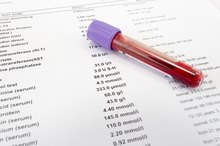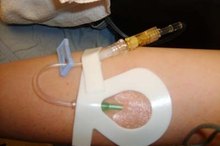Vacutainer Advantages & Disadvantages
A Vacutainer system is one method of performing venipunctures, or blood draws 1. The system consists of a plastic holder, a double-ended needle and Vacutainer tubes. One end of the double-sided needle is inserted into a hole at the top of the plastic holder and screwed on. The other side of the needle is inserted into the vein and the Vacutainer tube is inserted into the plastic holder to perform the blood draw.
If you are experiencing serious medical symptoms, seek emergency treatment immediately.
Accuracy
Unlike other venipuncture systems, which require the phlebotomist to accurately draw the correct amount of blood needed for a test, Vacutainer tubes are calibrated to fill to the specified amount needed. This helps reduce the necessity of repeat sticks to get enough blood for testing.
When other methods of phlebotomy are used, there is a risk that hemolysis, bursting of blood cells, may occur. One advantage of the Vacutainer system is that it draws blood into the tubes at a safe speed, reducing the risk of hemolysis.
With Vacutainer tubes, dilution of the blood is more accurate. Each tube is pre-filled with the appropriate amount of additive, reducing the likelihood that the dilution will be inaccurate.
- Unlike other venipuncture systems, which require the phlebotomist to accurately draw the correct amount of blood needed for a test, Vacutainer tubes are calibrated to fill to the specified amount needed.
- Each tube is pre-filled with the appropriate amount of additive, reducing the likelihood that the dilution will be inaccurate.
Efficiency and Safety
Venipuncture Methods
Learn More
The Vacutainer system is particularly effective when multiple samples are required. The phlebotomist simply waits until the first tube is filled and then replaces it with another tube. As long as the needle continues to be positioned correctly, multiple tubes can be inserted and filled.
The Vacutainer system of venipuncture uses a closed system which reduces the risk of spilled blood. This has the advantage of protecting the phlebotomist from inadvertent exposure to blood-born pathogens.
- The Vacutainer system is particularly effective when multiple samples are required.
- The Vacutainer system of venipuncture uses a closed system which reduces the risk of spilled blood.
Difficult to Use
One of the main disadvantages of Vacutainers is that there is no flashback to let the phlebotomist know that it is in the vein. If the needle is not in the vein and the phlebotomist attaches the tube, no blood will be drawn and the tube will have to be discarded. The needle will have to be repositioned and the patient re-stuck.
Another disadvantage of Vacutainer systems is that they are not well suited for difficult veins. Other blood draw systems offer more maneuverability, which is necessary in small veins or those that roll.
- One of the main disadvantages of Vacutainers is that there is no flashback to let the phlebotomist know that it is in the vein.
Trauma
How the Skeletal System Works With Other Systems in Your Body
Learn More
There is a greater chance of trauma with a Vacutainer system. Maneuvering the needle is more difficult and there is a potential to bruise the patient while positioning the needle in the vein.
Related Articles
References
Writer Bio
Denielle Radcliff is a freelance writer living in the mountains of western North Carolina. She has been writing professionally since 2008, both under her name and as a ghostwriter. She currently writes and maintains two blogs, Ancestrally Challenged and Free Genealogy Resources. She enjoys genealogy, hiking and waterfalls.









